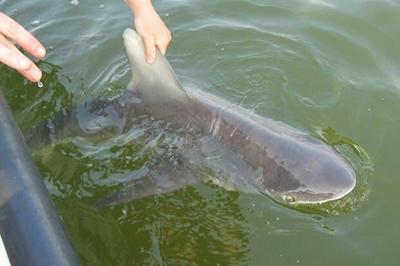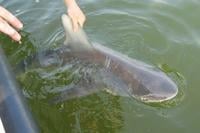(CAMBRIDGE, Md.)- As the heat of summer continues, people in the Chesapeake Bay region are spending more and more time on and in the water, which often leads to one of the biggest questions and concerns about safety in the Bay: Are there sharks in the Bay?
The answer to the question is yes, there are. In fact, there are at least 12 species of sharks found in the Bay, according to the Chesapeake Bay Program. Researchers say some are quite abundant, while others are very rare. Whether you need to be concerned about shark attacks while swimming or boating is another story though.
The sharks that are found in the Bay rarely pose a threat to human safety, but as with any wild creature, you'll want to be cautious. Sharks may be cool to look at, but the best option for their safety and yours is to leave them alone.
As of 2015, the Maryland Department of Natural Resources had not recorded any shark attacks in the Chesapeake Bay or in any of Maryland's waters. The International Shark Attack File records no unprovoked shark attacks in the state of Maryland and only five in the state of Virginia, none of which occurred in the Chesapeake.
There are five species of sharks that are common to abundant in the Chesapeake Bay. Be on the lookout for these species during the summer and fall, and make yourself aware of the risks associated with each of them. Some are considered more dangerous than others, but most will not cause any problems as long as you do not provoke them.
The most common shark found in the Chesapeake is the sandbar shark (Carcharhinus plumbeus). The sandbar shark can be found in the Atlantic Ocean from Massachusetts all the way to southern Brazil, and is a seasonal visitor to the Chesapeake Bay in the summer and fall.
Juvenile sandbar sharks are common to abundant in the Bay during this time of year. In fact, the Bay is one of the most important nursery areas on the East Coast for young sandbar sharks. But don't worry about a sandbar shark attack - it typically preys on bottom fishes, other sharks, rays and invertebrates. The Bay's blue crabs are a particular favorite of the sandbar shark.
The bull shark (Carcharhinus leucas) is a close cousin of the sandbar shark, but is more aggressive. The bull shark is an occasional summer visitor to the Chesapeake Bay, reaching as far north as the Patuxent River. It feeds on bony fishes, rays and other sharks (particularly juvenile sandbar sharks), in addition to crustaceans, turtles and mammals.
Many shark attacks have been attributed to bull sharks, since their behavioral habits bring them in close proximity to humans. While bull sharks are considered to be one of the three most dangerous shark species, they are not a significant threat to human safety in the Chesapeake Bay.
The sand tiger shark (Odontapis taurus) is a common visitor to the lower Bay during the summer and fall. It is most often found along the Bay's bottom and is active at night. It feeds mostly on small fishes, squids and other sharks. It is the primary predator of sandbar sharks near the Bay's mouth.
The sand tiger looks dangerous because of its size (up to 10 feet long) and jagged teeth, but there have been no recorded attacks on humans. However, as with any shark, it is recommended that humans do not provoke sand tiger sharks.
The smooth dogfish (Mustelus canis) is a common to abundant visitor to the Chesapeake Bay in the summer and fall. The smooth dogfish is only found in coastal areas of the western Atlantic, from Massachusetts to Venezuela and then from southern Brazil to Argentina. It is especially common in the lower Bay, as far north as the Patuxent River, in waters less than 60 feet deep. It is an active swimmer and feeds on large crustaceans and crabs at the Bay's bottom. Smooth dogfish usually travel in schools or packs.
The spiny dogfish (Squalus acanthias) is commonly found in the lower Bay south of the Potomac River in late fall through early spring. Like the smooth dogfish, it often travels in schools, but it is a much slower swimmer and inhabits deeper waters. The spiny dogfish is found in temperate coastal waters of all seas and oceans in the world.
Overall, sharks aren't a major safety concern in the Chesapeake Bay. The lower Bay's role as a nursery area for sandbar sharks makes it the most abundant large shark population on the Atlantic coast. But populations of other shark species are limited in this area, so unprovoked attacks are incredibly rare.
Still, next time you're out on the Bay, be on the lookout for some of these shark species for a little bit of a science lesson. Although they aren't as abundant or as culturally or economically valuable as many of the Bay's other species, they are still an important part of the Bay's ecosystem.
THIS ARTICLE WAS ORGINALLY POSTED BY THE CHESAPEAKE BAY PROGRAM










